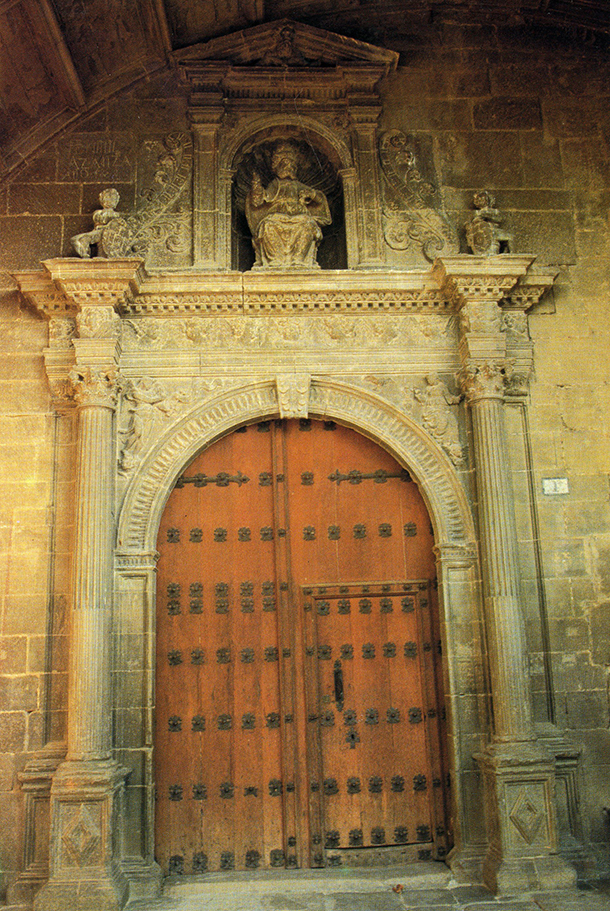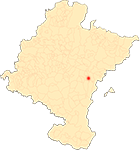Parish Church of San Pedro de Aibar
The 16th-century extension and the Renaissance façade
Coinciding with the arrival of the Renaissance, an enlargement was carried out on a parish church that would appear small and poor to the eyes of the spectator of the fifteenth century. The Renaissance extension consisted of opening a spacious Wayside Cross to the nave and a rectangular main chapel with a sacristy on the epistle side. The new work, in keeping with the previous Gothic tradition, covered its three bays with moulded ribbed vaults resting on semicircular corbels. The main chapel and the sacristy also use these coverings. A moulding runs around the entire space of the Wayside Cross , giving it greater unity and character. In fact, the greater spatial unity announces to the viewer that, despite the Gothic traces, he or she is in a Renaissance environment. This intervention was carried out between 1542 and 1545 by the master Lázaro de Iriarte, one of the "church masons" who worked in the area average in the mid-16th century. According to Echeverría Goñi, this parish church is the most important work A of its author, whose works include the church of Cáseda.
However, the highlights of the Renaissance extension are the portico and doorway on the Epistle side. In contrast to the Gothic interior, all the elements in fashion in the second third of the 16th century can be seen here: coffered ceilings, semicircular arches, classical columns and pilasters, entablatures and scallops. In this sense, the portico, popularly known in the locality as the 'portegao', opens to the exterior through a round arch on segmental pilasters. The soffit of the arch is decorated with floral coffers. The interior of the portico is covered by a barrel vault with plain rectangular coffers.
Inside the portico, off-centre, there is a doorway very similar to the one in Cáseda by the same author. In the Aibar doorway, Lázaro de Iriarte showed a knowledge of the architectural treatises of the time, such as the Medidas del Romano by Diego de Sagredo (1526), to which this doorway is indebted. In fact, Iriarte applies what Sagredo proposed by creating a triumphal arch crowned by a niche. The central element of the doorway is the large semicircular arch that gives access to the church. The doorway is flanked by two columns with Corinthian capitals resting on pedestals. Above the columns is an entablature that ends in an attic with a niche between recessed pilasters crowned by a triangular pediment. The sculptural decoration is set above these architectural elements. In the spandrels of the arches is the scene of the Annunciation, the frieze houses the heads of cherubs and the niche of the patron saint of the church: Saint Peter. The Apostle in his Chair and with the attributes of supreme pontiff in an attitude of blessing. The pediment houses the image of the Eternal Father and the Holy Spirit. Other decorative motifs are the lateral flaps with two children holding the arms of the town.
ARAGONÉS, E., "El románico de Sangüesa", El Arte en Navarra, volume 1, Pamplona, Diario de Navarra, 1994, pp. 65-80.
FERNÁNDEZ GRACIA, R., ANDUEZA UNANUA, P., AZANZA LÓPEZ, J. and GARCÍA GAINZA, M.C., El arte del Barroco en Navarra, Pamplona, Gobierno de Navarra, 2014.
FERNÁNDEZ GRACIA, R., ECHEVERRÍA GOÑI, P.L. and GARCÍA GAINZA, M.C., El arte del renacimiento en Navarra, Pamplona, Gobierno de Navarra, 2005.
FERNÁNDEZ-LADREDA, C., MARTÍNEZ DE AGUIRRE, J. and MARTÍNEZ ÁLAVA, C.J., El arte románico en Navarra, Pamplona, Gobierno de Navarra, 2004.
FERNÁNDEZ-LADREDA, C., MARTÍNEZ ÁLAVA, C.J., MARTÍNEZ DE AGUIRRE, J. and LACARRA DUCAY, M.C., El Arte Gótico en Navarra, Pamplona, Gobierno de Navarra, 2015.
GARCÍA GAINZA, M.C. and ORVE SIVATTE, M., Catalog Monumental de Navarra. Merindad de Sangüesa, volume IV*, Pamplona, Government of Navarra, 1989.
GARCÍA GAINZA, M.C., La Escultura Romanista en Navarra, Pamplona, Government of Navarre, 1986.
HEREDIA MORENO, M.C., ORVE SIVATTE, M. and ORVE SIVATTE, A., Arte hispanoamericano en Navarra. Silver, painting and sculpture. Pamplona, Government of Navarre, 1992.
IZIZ ELARRE, R., Aibar-Oibar. Historia, volume 1, Tafalla, Altaffaylla Kultur Taldea, 2008.
LARRIÓN, J.L., "Romerías", Temas de Cultura Popular, number 42, Pamplona, Diputación Foral de Navarra, 1969.
LEOJENDIO, L.M., "pathway del Románico", Temas de Cultura Popular, number 85, Pamplona, Diputación Foral de Navarra, 1975.
SAGASETA, A. and TABERNA, L. Órganos de Navarra, Pamplona, Government of Navarre, 1985.












